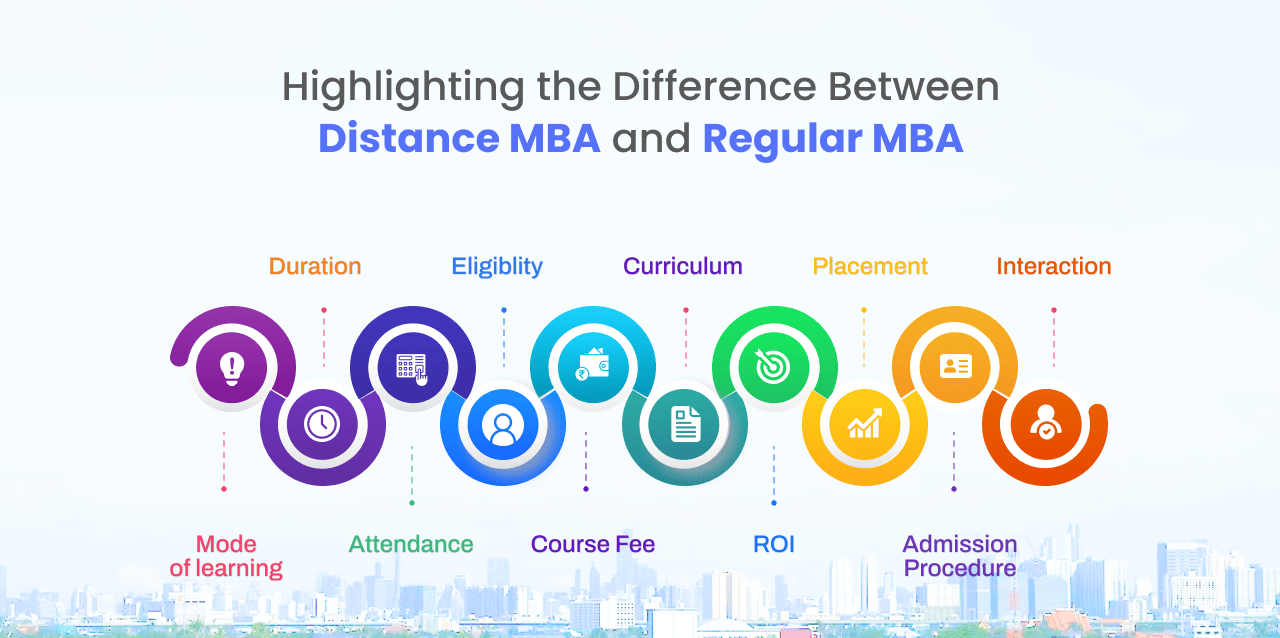
Table Of Contents
▲Is distance MBA better than Regular MBA?
Choosing to pursue a Master of Business Administration (MBA) is a pivotal decision that can significantly impact your career trajectory and professional growth. As the field of business management education continues to evolve, MBA candidates are now faced with a crucial choice: a Distance or Regular MBA.
In this blog, we aim to provide a comprehensive understanding of the difference between Distance MBA and Regular MBA. Our goal is to equip you with the knowledge to make an informed decision that aligns with your career goals.
Overview of Distance MBA Vs Regular MBA
What is a Distance MBA?
A distance learning MBA or MBA in Correspondence is another alternative for students who prefer a flexible learning schedule and dislike the physical study option. This format provides learning materials through printed books or other offline resources. Students who communicate with instructors via mail, phone or occasional offline meetings.
What is Regular MBA?
Regular MBA courses, also known as full-time, traditional, or on-campus MBAs, are much-desired degrees. In this format, students mostly go for physical classes, interact with faculty, meet with peer members, and engage in group discussions with professors and peers. Regular MBA courses offer a comprehensive learning experience and provide students with rich networking connections that can be invaluable throughout their careers.
Now that you've learnt the difference between Distance MBA and Regular MBA, let’s explore its pros and cons.
Pros and Cons of Distance MBA vs Regular MBA
Here are the pros and cons of two distinctive degrees of Distance MBA vs Regular MBA
1. Pros of a Distance MBA Course
The pros of pursuing an MBA through distance MBA are:
Flexibility:
Flexible learning allows students to study at their own pace and from anywhere, making it ideal for working professionals. Students are more prone to flexible learning, enabling them to study at their own pace from anywhere in the world. It allows working professionals to study while continuing their job and other responsibilities.
Affordability:
Distance MBA comes with budget-friendly cost as it eliminates the extra cost of commuting and accommodation.
Accessibility:
Distance MBA removes geographical barriers, allowing candidates to pursue an MBA regardless of their location.
Career Advancement:
Learning the difference between Distance MBA and Regular MBA enables professionals to upgrade their skills and advance their careers without compromising their current employability.
Time Management:
Distance MBA requires robust time management skills, which can be a valuable asset in the professional environment.
2. Cons of a Distance MBA Course
The cons of doing a distance MBA are:
Limited Networking:
A distance MBA may offer fewer opportunities than an on-campus MBA program, which includes interactions, group discussions, case studies, etc.
Less Immersive Experience:
Distance MBA learning ceases daily campus events, physical interactions, webinars, etc., limiting the overall learning experience.
Self-Discipline Required:
Distance MBA students require strong time management and self-motivation skills, as students are expected to manage their own schedules
Perception and Recognition:
Some employers may disregard the value of a distance MBA over that of a regular MBA, potentially impacting career advancement.
Limited Interaction with Professors and Peers:
Communication delays and fewer opportunities for real-time feedback can hinder learning and collaboration.
3. Pros of Regular MBA
Pros of pursuing a regular MBA:
Immersive Learning:
The Regular MBA offers a traditional classroom setting with direct interaction with professors and classmates, providing an engaging and vibrant learning experience.
Networking:
The regular MBA offers ample networking opportunities to help candidates build connections with peers, faculty, and industry professionals through campus webinars, interactions, and events.
Career Placement:
Regular MBA programs offer placement assistance and internships, which can lead to direct career opportunities after graduation.
Potential for Higher Earnings:
An MBA degree often leads to higher salary and more career options in the job market, instilling a sense of optimism and motivation about your future career prospects.
Leadership and Management Development:
The regular MBA course curriculum focuses on building leadership and management skills, which are highly sought after in the business world
4. Cons of Regular MBA
Cons of Pursuing a Regular MBA:
Cost:
A regular MBA course can be highly expensive, including tuition fees, living expenses, and other associated costs.
Time Commitment:
Full-time MBA programs require a vital time commitment, potentially making it difficult for working professionals to balance their work and studies.
Structured Schedule:
Regular MBA programs often have a rigid schedule with set class times, which may not be flexible enough for all the students.
Limited Flexibility:
Regular MBA programs need students who can attend physical classes, which may not be an ideal option for working professionals seeking a flexible learning structure.
Relocation:
Regular MBA classes require students to relocate to attend physical classes, which can be a significant expense and disruption.
Highlighting the Difference Between Distance MBA vs Regular MBA

Let’s comprehensively understand the difference between Distance MBA vs Regular MBA.
| Parameters | Distance MBA | Regular MBA |
|---|---|---|
| Mode of learning | Primarily online, with occasional on-campus requirements. | Classroom-based with daily in-person interaction. |
| Duration | A regular MBA course lasts two years. The length of the program is not flexible. | The course is a minimum of two years, but extending it to five years is possible. |
| Attendance | Not required. | Required for each class. |
| Eligibility | Bachelor’s degree | A bachelor’s degree and work experience may be preferred. |
| Course Fee | Potentially most affordable | Typically most expensive |
| Curriculum | For a distance MBA, the curriculum is primarily dependent on course materials. | The course curriculum of the regular MBA program includes both theoretical and practical classes. |
| ROI | ROI differs; it depends on the program and the skills gained by the candidates. | Typically offers a lower ROI due to higher tuition, infrastructure, and commuting expenses. |
| Placement | The universities offer placement assistance. Some universities arrange placement drives. | Placement procedures are conducted at the end of each academic calendar year. Often, the top companies tie up with the programs and hire the students who graduate. |
| Admission Procedure | For admission, you are required to fill up the application form and pay the fees to complete the procedure. | The admission procedure is complicated. Candidates must qualify in a state—or national-level entrance examination. Interviews and group discussions are also mandatory. |
| Interaction | Limited interaction with peers and faculty, mostly through digital means. | In-person interaction with peers and faculty. |
Which are the Top universities for Distance MBA vs Regular MBA
Here is a comparison between top universities offering cost-effective and expensive fees.
| Top University | Distance MBA Fees in INR/Regular MBA Fees in INR |
|---|---|
| IGNOU | 63,000 |
| Amity University | 1,79,000 |
| Symbiosis Centre For Distance Learning | 50,000 |
| Lovely Professional University | 1,62,800 |
| Chandigarh University | 17,840 |
| IIM Ahmedabad | 25,00,000 |
| IIM Bangalore | 25,00,000 |
| Indian School of Business | 41,00,000 |
| FMS, Delhi | 2,00,000 |
Please note: The Fees mentioned above for the distance MBA vs Regular MBA above is subject to change over time.
How to Choose Between Distance MBA vs Regular MBA?

Your choice between a Distance MBA vs Regular MBA depends on multiple factors:
Career Goals
Enrolling for a regular MBA is preferred if you aim for managerial positions in top MNCs, Banks, or Startups.
If you don’t want to lose your current employment and also want to upgrade your career, then choosing a distance MBA is a better choice.
Budget Considerations
Pursuing a regular MBA from prestigious institutions like IIMs, XLRI, and ISB costs you expensive amounts of money, up to 10-25 Lakhs.
Distance MBAs are more affordable, ranging from ₹50,000 to ₹3 lakhs, helping you gain all fundamental knowledge about business management studies.
Learning Style
If you want to learn structured learning, interactive sessions and teamwork, go for a Regular MBA.
If you are a self-motivated learner who prefers flexible learning, consider a Distance MBA, which allows you to study at your own pace.
Work Commitments
A Regular MBA requires full-time commitment.
A Distance MBA allows you to work and study flexibly at your own pace.
Networking & Placements
Regular MBAs offer robust networking and campus placements.
While Distance MBAs have limited placement support.
Conclusion
The decision to pursue an MBA is a must-have degree, but choosing the right format is equally critical. Whether you opt for the immersive regular MBA or the distance MBA, both modes have their own advantages and limitations. Consider your personal choice, professional responsibilities and future career goals while making the selection.
If networking and campus experience are important, then choosing the regular MBA might be the ideal fit, and for those seeking flexibility and convenience, a Distance MBA can be a viable option. No matter what you choose, distance MBA vs regular MBA. It will allow you to have your own advantages and disadvantages.
Remember that the quality of the MBA course and its accreditation also play a vital role in the decision-making process. Whatever option you choose, dedication, hard work, and a thirst for knowledge will ensure a successful MBA direction, propelling you to thrive in a growing career in the dynamic world of business.
FAQ
What is the difference between Distance MBA and Regular MBA?
Is a distance MBA valid for jobs?
Is the value of a Distance MBA vs Regular MBA the same in the job market?
Enroll with Us

Recent Blogs
 Is Distance MBA Right for You?
Is Distance MBA Right for You?16 April 2025
 Online MBA vs Online PGDM: Which Course is Better?
Online MBA vs Online PGDM: Which Course is Better?24 April 2024
 How Online PGD in Marketing Can Boost Your Career?
How Online PGD in Marketing Can Boost Your Career?24 April 2024
Confused about your career path?
Connect with an expert counsellor today!
LIFETIME FREE
Our Top Mentor

⭐ 4.7
Ravinder Kumar
4 years experience
Sr. Mentor MCA

⭐ 4.6
Anuj Chand
6 years experience
Sr. Mentor BBA

⭐ 4.6
Dhruv Pahwa
4 years experience
Sr. Mentor MCA

⭐ 4.8
Ruchi Parashar
5 years experience
Sr. Mentor BCA

Categories
- > Online MBA
- > Online MCA
- > Online M.Sc
- > Online BBA
- > Online BCA
- > Online BA
- > Online PGDM
- > Online Certifications
Trending Search
- > Online MBA Fees 2025
- > Online MBA Admission Process
- > Online MBA Syllabus
- > Online BBA Fees 2025
- > Online PGDM Fees 2025
- > Best Online PGDM Colleges in India
- > Best Online BCA Colleges
- > Online BCA Admission 2025
- > Online BA Admission Process
- > Best Online MA Programs
- > Best Online Universities in India
- > Online Degree Courses in India
- > Best Online Courses for Working Professionals
- > Career after Online MBA
- > Online BBA Program
Tags
- > Distance MBA vs Regular MBA
- > Distance MBA Fees
- > Regular MBA Fees
- > Distance MBA Admission
- > Regular MBA Fees
- > Distance MBA Jobs
- > Regular MBA Career

At MBA Query, we are delighted to help students with their admission journey. We offer proper guidance on choosing management programs, selecting ideal specialisations, and crafting a smooth, step-by-step application.
Top Universities
Best Online Courses
Opening Hours
10:00 AM - 7:00 PM
Monday - Saturday
Info@mbaquery.com
Cities
Mumbai | Hyderabad | Gurugram | Jaipur
Resources
Reviews | Admission Guides | Career Counseling | Scholarship Assistance
Enroll with Us




